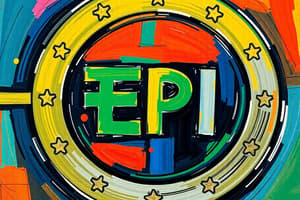Podcast
Questions and Answers
What primarily characterizes the transmission mechanism of monetary policy?
What primarily characterizes the transmission mechanism of monetary policy?
- It is limited to the interest rate channel.
- It has long, variable, and uncertain time lags. (correct)
- It operates in a predictable manner.
- It only affects long-term interest rates.
Which of the following describes the effect of higher interest rates on consumer behavior?
Which of the following describes the effect of higher interest rates on consumer behavior?
- Increases borrowing and boosts consumption.
- Stimulates credit availability from banks.
- Encourages investment across all sectors.
- Reduces borrowing and lowers inflation. (correct)
In the context of the exchange rate channel, what effect does a stronger peso have on goods?
In the context of the exchange rate channel, what effect does a stronger peso have on goods?
- Neither impacts imports nor exports.
- Makes imports cheaper and exports more expensive. (correct)
- Has no effect on trade dynamics.
- Increases the cost of imports and decreases the price of exports.
How do changes in policy rates impact consumer spending through the credit channel?
How do changes in policy rates impact consumer spending through the credit channel?
What is a direct impact of lower interest rates on asset prices?
What is a direct impact of lower interest rates on asset prices?
Which mechanism primarily influences public expectations about economic conditions?
Which mechanism primarily influences public expectations about economic conditions?
What effect can a weaker peso have on the economy?
What effect can a weaker peso have on the economy?
Which of the following channels directly influences the availability of credit?
Which of the following channels directly influences the availability of credit?
What impact do stable inflation expectations have on consumers and businesses?
What impact do stable inflation expectations have on consumers and businesses?
What does the inflation rate measure?
What does the inflation rate measure?
Why is GDP growth significant for the BSP?
Why is GDP growth significant for the BSP?
What does a high unemployment rate suggest to the BSP?
What does a high unemployment rate suggest to the BSP?
What does a surplus in the Balance of Payments (BOP) indicate?
What does a surplus in the Balance of Payments (BOP) indicate?
What is indicated by a high Consumer Confidence Index?
What is indicated by a high Consumer Confidence Index?
What does a large fiscal deficit often lead to?
What does a large fiscal deficit often lead to?
How does the BSP use information about economic indicators?
How does the BSP use information about economic indicators?
Flashcards are hidden until you start studying
Study Notes
Transmission Mechanisms of Monetary Policy
- Monetary policy decisions impact the economy and price levels via a transmission mechanism.
- This mechanism operates through five channels: interest rate, exchange rate, credit, asset price, and expectations.
Interest Rate Channel
- Changes in policy interest rates alter short-term market interest rates, influencing long-term borrowing rates (loans, bonds).
- Higher interest rates increase borrowing costs, reducing consumption and investment, which potentially lowers inflation.
- Conversely, lower interest rates make borrowing cheaper, stimulating consumption and investment.
Exchange Rate Channel
- Adjustments to policy rates can impact the exchange rate of the Philippine peso.
- Higher interest rates may attract foreign investment, strengthening the peso.
- A stronger peso can lower the cost of imports, making exports pricier, affecting trade balance and inflation. Conversely, a weaker peso can enhance exports but raises import costs and inflation.
Credit Channel
- Policy rate changes affect borrowing costs and the availability of credit from banks.
- Tighter monetary policy can reduce bank lending, increasing credit costs.
- Expensive or less accessible credit can curtail consumer spending and business investment, slowing economic activity. Easier credit conditions may spur spending and investment.
Asset Price Channel
- Interest rate fluctuations may influence asset prices, such as stocks and real estate.
- Lower interest rates can elevate asset prices, while higher rates typically depress them.
- Rising asset prices can enhance wealth and boost spending (wealth effect); declining asset prices may reduce spending.
Expectations Channel
- The Bangko Sentral ng Pilipinas (BSP) policy decisions shape future economic expectations.
- Confidence in stable inflation and growth encourages consumers and businesses to spend and invest more.
- Anchored inflation expectations increase monetary policy effectiveness as decisions are based on anticipated economic conditions.
Key Economic Indicators
- Inflation Rate: Measures the increase in the general price level of goods and services. Significant for BSP's mandate of price stability with a target guiding monetary policy.
- Gross Domestic Product (GDP): Represents the total value of produced goods and services over a period. GDP growth indicates economic health; BSP utilizes it to support sustainable growth.
- Unemployment Rate: Percentage of the labor force actively seeking work. High rates may necessitate accommodative monetary policy to stimulate economic activity.
- Balance of Payments (BOP): Indicates the difference between total exports and imports. A BOP surplus bolsters the peso; a deficit weakens it, essential for BSP's external stability monitoring.
- Consumer Confidence Index: Reflects consumers' optimism about the economy and personal finances. High confidence typically leads to increased spending and investment.
Fiscal Deficit
- Measures the gap between government expenditures and revenues.
- A significant fiscal deficit may lead to higher interest rates and inflation, influencing BSP policy decisions.
Studying That Suits You
Use AI to generate personalized quizzes and flashcards to suit your learning preferences.




